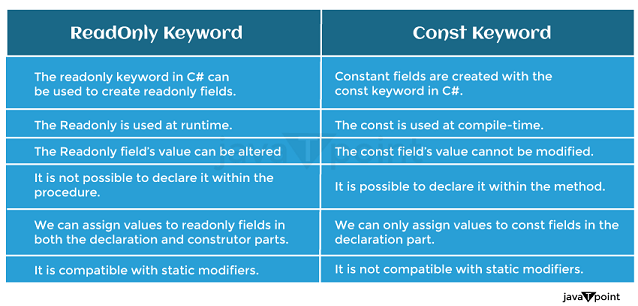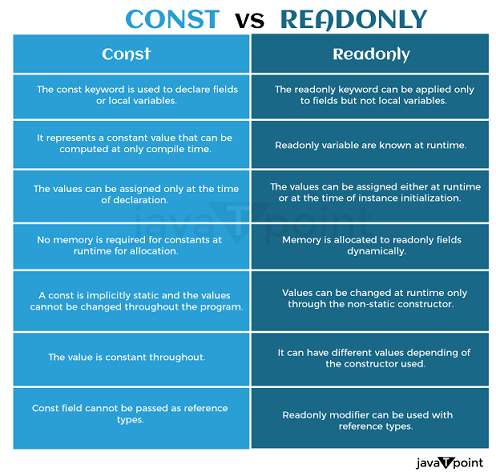Difference between readonly and Constant in C#In C#, both readonly and const are used to declare values that cannot be modified at runtime. These two terms do differ in some significant ways, though. What is Constant?Const is a compile-time constant, meaning its value is determined at compile-time and cannot be changed at runtime. It is usually used to declare global constants, such as mathematical constants or other values that are not expected to change during the execution of the program. Const values are always static and implicitly static, meaning they belong to the class and not to an instance of the class. They are also implicitly public, meaning they can be accessed anywhere in the code. 
What is readonly?On the other hand, readonly fields are runtime constants, meaning their value is determined at runtime and can be changed only in the class's constructor. The readonly fields are instance-level variables, meaning each class instance has its copy of the field. They can also be designated as static, which denotes that they belong to the class and not a particular class instance. The readonly fields are not implicitly public, so you must specify the access level explicitly. Here is an illustration of the use of const in C#: Main Differences between readonly and constant in C#In C#, the const and readonly keywords are used to define constants, but there are some differences in how they are used and what they can do.
Here's an example that illustrates the differences between const and readonly: In this example, Value1 is a const value set at compile time to the value of 10. On the other hand, Value2 is a readonly value that can only be set at runtime and is set in the class's constructor.
When deciding whether to use const or readonly, consider the purpose of the value and whether it is expected to change at runtime. Use const for values that are truly constant and never change, and use readonly for values that may change at runtime but should be set only once during the object's lifetime. Const and readonly define constants in C# but have different uses and limitations. Const values are determined at compile time, are always implicitly static and public, and cannot be changed at runtime. readonly values are determined at runtime, can be instance-level or static, and can be changed only in the class's constructor. Here is the difference between const and readonly in brief 
Advantages of readonly in C#The readonly keyword in C# offers several advantages when used appropriately. Here are some key advantages of using readonly in your code: Immutable Values: By using readonly, you can create variables or fields whose values cannot be modified once assigned. This immutability ensures that the value remains constant throughout the object's lifetime, promoting code clarity and preventing accidental modifications that could lead to unexpected behavior. Runtime Initialization: Unlike const values, readonly fields can be initialized at runtime within the constructor of a class. It allows you to assign values to readonly fields based on dynamic or calculated conditions during object instantiation, providing flexibility in initializing constant values. Instance-Specific Values: Unlike const values, readonly fields can have different values for each instance of a class. It makes readonly useful when you need instance-specific constant values, as each object can have its unique value for the readonly field. Lazy Initialization: You can utilize readonly fields for lazy initialization, where the value is computed or retrieved only when it is first accessed. It can help improve performance by deferring expensive or time-consuming operations until they are needed. Compatibility with Libraries: The readonly keyword works with other libraries and frameworks, enabling you to take advantage of the code and best practices already in use. It is commonly used in APIs and libraries to expose constant values or configurations that consumers should not modify. Thread Safety: The readonly fields can contribute to thread safety by ensuring that their values are not modified after initialization. In multi-threaded scenarios, where concurrent access to shared data is involved, using readonly can help avoid race conditions and data corruption issues. Debugging and Readability: By marking certain fields as readonly, you communicate your intent to other developers, indicating that the value should not be modified. This can enhance code readability and maintainability and make debugging issues related to constant values easier. It's important to note that while readonly provides advantages for immutability and constant values, it should be used judiciously. It can result in unexpected behaviour or make the code more difficult to maintain if the readonly modifier is applied to fields that are not meant to be constants. Carefully consider the design and requirements of your application before deciding to use readonly fields. Advantages of constant in C#The const keyword in C# provides several advantages when used appropriately. Here are some key advantages of using const in your code: Compile-time Constant: The const values are determined at compile time, meaning their values are directly embedded into the compiled code. It eliminates the need for runtime calculations or retrievals, resulting in optimized and efficient code execution. Performance Optimization: Since const values are resolved at compile time, they can be used in performance-critical sections of your code without incurring any runtime overhead. It can lead to faster execution and improved overall performance of your application. Global Constants: The const values are typically used to define global constants that remain unchanged throughout the execution of the program. By declaring these constants, you ensure their values cannot be accidentally modified during runtime, enhancing code predictability and preventing unintended side effects. Code Clarity and Readability: By using const, you explicitly indicate to other developers that a particular value is constant and should not be modified. It improves the clarity and maintainability of your code by providing a clear distinction between constant and mutable values. Integration with Compilation and Tooling: Using const aligns with the compilation process and various development tools. It allows for better static analysis, error checking, and code navigation within integrated development environments (IDEs). The compile-time nature of const enables tools to provide better IntelliSense, refactoring support, and code completion. Better Documentation: Constants declared using const provide self-documenting code. You create a clear and descriptive codebase by giving meaningful names to your const values. It eliminates the need for additional comments or documentation and makes it simpler for developers to comprehend the function and importance of these constants. Integration with Libraries and APIs: The const values are compatible with libraries and APIs, making them suitable for exposing constant values or configurations that are not expected to change. This allows for easy integration with third-party libraries and ensures consistency in behavior across different parts of your application. It's important to note that const has some limitations. It can only be used with certain primitive types and string literals, and its value must be known at compile time. Additionally, const values are implicitly static and public, which means they are shared across all instances of a class and can be accessed from anywhere in the code. Therefore, based on the particular requirements of your application, significant thought should be given to the applicability of const.
Next TopicHow to Call Stored Procedure in C#
|
 For Videos Join Our Youtube Channel: Join Now
For Videos Join Our Youtube Channel: Join Now
Feedback
- Send your Feedback to [email protected]
Help Others, Please Share










